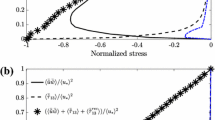Abstract
An equation is derived for the components of the horizontal (turbulent) frictional force in the Σ-coordinate system with special attention to mesometeorological flow models. The starting point is the horizontal equation of motion in its “flux-form” in the Σ-system in which we replace (following Reynolds' procedure) the velocity components u,v and % MathType!MTEF!2!1!+- % feaafeart1ev1aaatCvAUfeBSjuyZL2yd9gzLbvyNv2CaerbuLwBLn % hiov2DGi1BTfMBaeXatLxBI9gBaerbd9wDYLwzYbItLDharqqtubsr % 4rNCHbGeaGqiVu0Je9sqqrpepC0xbbL8F4rqqrFfpeea0xe9Lq-Jc9 % vqaqpepm0xbba9pwe9Q8fs0-yqaqpepae9pg0FirpepeKkFr0xfr-x % fr-xb9adbaqaaeGaciGaaiaabeqaamaabaabaaGcbaGafq4WdmNbai % aaaaa!37B8! \[ \dot \sigma \] aswell as other relevant quantities by terms of the form u = ū + u′,..., Σ = ±Σ + % MathType!MTEF!2!1!+- % feaafeart1ev1aaatCvAUfeBSjuyZL2yd9gzLbvyNv2CaerbuLwBLn % hiov2DGi1BTfMBaeXatLxBI9gBaerbd9wDYLwzYbItLDharqqtubsr % 4rNCHbGeaGqiVu0Je9sqqrpepC0xbbL8F4rqqrFfpeea0xe9Lq-Jc9 % vqaqpepm0xbba9pwe9Q8fs0-yqaqpepae9pg0FirpepeKkFr0xfr-x % fr-xb9adbaqaaeGaciGaaiaabeqaamaabaabaaGcbaGafq4WdmNbai % Gbauaaaaa!37C3! \[ \dot \sigma ' \] ′, etc. (ū = time average of u; u′ = fluctuating part of u.) Next, the equation is averaged with respect to time and terms which we believe are small in mesometeorological flows, are neglected. On expressing Σ′ by an appropriate expression that involves w′, the result shows the appearance of two new terms which, have not been considered previously in the published literature. While the expression earlier used in the literature involved the Σ-derivative of % MathType!MTEF!2!1!+-% feaafeart1ev1aaatCvAUfeBSjuyZL2yd9gzLbvyNv2CaerbuLwBLn% hiov2DGi1BTfMBaeXatLxBI9gBaerbd9wDYLwzYbItLDharqqtubsr% 4rNCHbGeaGqiVu0Je9sqqrpepC0xbbL8F4rqqrFfpeea0xe9Lq-Jc9% vqaqpepm0xbba9pwe9Q8fs0-yqaqpepae9pg0FirpepeKkFr0xfr-x% fr-xb9adbaqaaeGaciGaaiaabeqaamaabaabaaGcbaWaa0aaaeaace% WG1bGbauaaceWG3bGbauaaaaaaaa!380B!\[\overline {u'w'} \] alone, the new terms add the Σ-derivatives of ρα % MathType!MTEF!2!1!+-% feaafeart1ev1aaatCvAUfeBSjuyZL2yd9gzLbvyNv2CaerbuLwBLn% hiov2DGi1BTfMBaeXatLxBI9gBaerbd9wDYLwzYbItLDharqqtubsr% 4rNCHbGeaGqiVu0Je9sqqrpepC0xbbL8F4rqqrFfpeea0xe9Lq-Jc9% vqaqpepm0xbba9pwe9Q8fs0-yqaqpepae9pg0FirpepeKkFr0xfr-x% fr-xb9adbaqaaeGaciGaaiaabeqaamaabaabaaGcbaWaa0aaaeaace% WG1bGbauaadaahaaWcbeqaaiaaikdaaaaaaaaa!37EC!\[\overline {u'^2 } \] and ρβ % MathType!MTEF!2!1!+-% feaafeart1ev1aaatCvAUfeBSjuyZL2yd9gzLbvyNv2CaerbuLwBLn% hiov2DGi1BTfMBaeXatLxBI9gBaerbd9wDYLwzYbItLDharqqtubsr% 4rNCHbGeaGqiVu0Je9sqqrpepC0xbbL8F4rqqrFfpeea0xe9Lq-Jc9% vqaqpepm0xbba9pwe9Q8fs0-yqaqpepae9pg0FirpepeKkFr0xfr-x% fr-xb9adbaqaaeGaciGaaiaabeqaamaabaabaaGcbaWaa0aaaeaace% WG1bGbauaaceWG2bGbauaaaaaaaa!380A!\[\overline {u'v'} \] for the x-component of the force, and the Σ-derivatives of ϱβ % MathType!MTEF!2!1!+-% feaafeart1ev1aaatCvAUfeBSjuyZL2yd9gzLbvyNv2CaerbuLwBLn% hiov2DGi1BTfMBaeXatLxBI9gBaerbd9wDYLwzYbItLDharqqtubsr% 4rNCHbGeaGqiVu0Je9sqqrpepC0xbbL8F4rqqrFfpeea0xe9Lq-Jc9% vqaqpepm0xbba9pwe9Q8fs0-yqaqpepae9pg0FirpepeKkFr0xfr-x% fr-xb9adbaqaaeGaciGaaiaabeqaamaabaabaaGcbaWaa0aaaeaace% WG2bGbauaadaahaaWcbeqaaiaaikdaaaaaaaaa!37ED!\[\overline {v'^2 } \]} and ϱα % MathType!MTEF!2!1!+-% feaafeart1ev1aaatCvAUfeBSjuyZL2yd9gzLbvyNv2CaerbuLwBLn% hiov2DGi1BTfMBaeXatLxBI9gBaerbd9wDYLwzYbItLDharqqtubsr% 4rNCHbGeaGqiVu0Je9sqqrpepC0xbbL8F4rqqrFfpeea0xe9Lq-Jc9% vqaqpepm0xbba9pwe9Q8fs0-yqaqpepae9pg0FirpepeKkFr0xfr-x% fr-xb9adbaqaaeGaciGaaiaabeqaamaabaabaaGcbaWaa0aaaeaace% WG1bGbauaaceWG2bGbauaaaaaaaa!380A!\[\overline {u'v'} \] for the y-component, where α and β are the slopes of the Σ-surfaces in the x- and y-directions, respectively. Further, a few numerical simulations of the sea-breeze over topography are carried out with and without the correction terms. It is shown that when corrections terms are not included the effective smoothing is stronger above the sloping regions and may amount to as high as 50 percent of the convergence with slopes of ~.04. The ìnclusìon of the new terms does not lead to any special computational difficulties and for that reason there is no compelling reason to neglect them, all the more so because, as is shown, the addition of the new terms results in a consistent apportioning of the ‘degree’ of horizontal diffusion.
Similar content being viewed by others
References
Alpert, P.: 1981, Implicit filtering in conjunction with explicit filtering, J. Comput. Phys. 44, 212–219.
Alpert, P., A. Cohen, E. Doron., and J. Neumann: 1982, A model simulation of the summer circulation from the eastern Mediterranean past Lake Kinneret in the Jordan Valley, Mon. Wea. Rev. 110, 994–1006.
Anthes, R.A., and T.T. Warner:1978, The development of mesoscale models suitable for air pollution and other mesometeorological studies, Mon. Wea. Rev. 106, 1045–1078.
Batchelor, G.K.: 1956, The theory of homogenous turbulence, Cambridge Univ. Press, 197 pp.
Berkofsky, L. and E.A. Bertoni: 1955, Mean topographic charts for the entire earth. Bull. Amer. Met. Soc. 36, 350–354.
Blackadar, A.K.: 1978, High resolution models of the planetary boundary layer, Advances in Environmental and Scientific Engineering, Vol.1, Gordon and Breach, 276 pp.
Gal-Chen, T., and R.C.J. Somerville: 1975, On the use of a coordinate transformation for the solution of the Navier-Stokes equations. J. Comput. Phys. 17, 209–228.
Gifford, F.A.: 1982, Horizontal diffusion in the atmosphere: A Langrangian-dynamical theory, Atmos. Environ. 16, 505–512.
Haltiner, G.J.: 1971, Numerical Weather Prediction, J. Wiley, New York, 317 pp.
Holton, J.R.: 1973, An Introduction to Dynamic Meteorology, Academic Press, New York, 319 pp.
Long, P.E., W.A. Shaffer, J.E. Kemper and F.J. Hicks 1978: The state of the techniques development laboratory's boundary layer model, 24 May 1977, NOAA Tech. Memo. NWS TDL 66, Silver Spring, MD 63 pp.
Mahrer, Y.: 1982, A theoretical study of the effect of soil surface shape upon the soil temperature profile, Soil Science, 134, 381–387.
Mahrer, Y., and R.A. Pielke: 1978, A test of an upstream spline interpolation technique for the advective terms in a numerical mesoscale model. Mon. Wea. Rev. 106, 818–830.
Marchuk, G.I.: 1974, Numerical Methods in Weather Prediction, Academic Press. 277 pp.
Mason, P.J. and R.I. Sykes: 1978, On the interaction of topography and Ekman boundary layer pumping in a stratified atmosphere, Quart. J. R. Met. Soc. 104, 475–490.
Paegle, J., W.J. Zdunkowsky and R.M. Walch: 1976, Implicit differencing of predictive equations of the boundary layer, Mon. Wea. Rev. 104, 1321–1324.
Pielke, R.A., and C.L. Martin: 1981, The derivation of a terrain following coordinate system for the use in a hydrostatic model, J. Atmos. Sci. 38, 1707–1713.
Sutton, O.G.: 1953, Micrometeorology, McGraw-Hill, New York, 333 pp.
Tennekes, H., and J.L. Lumley.: 1972, A first course in turbulence, MIT Press, 300 pp.
Author information
Authors and Affiliations
Additional information
On leave from CIMMS, Norman, OK.
Now visiting Dept. of Met., Helsinki, Finland.
Rights and permissions
About this article
Cite this article
Alpert, P., Neumann, J. On the enhanced smoothing over topography in some mesometeorological models. Boundary-Layer Meteorol 30, 293–312 (1984). https://doi.org/10.1007/BF00121958
Issue Date:
DOI: https://doi.org/10.1007/BF00121958




